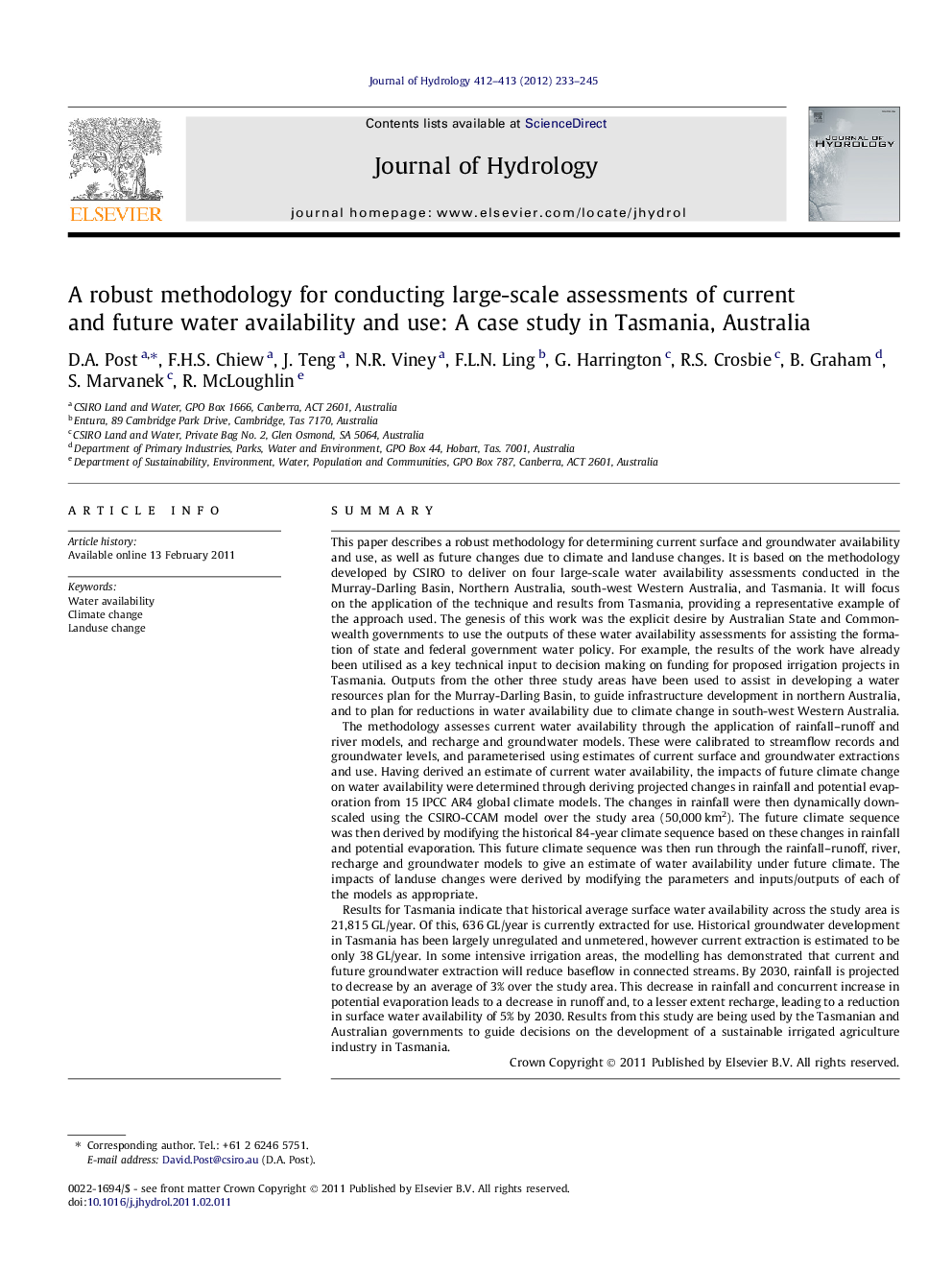| کد مقاله | کد نشریه | سال انتشار | مقاله انگلیسی | نسخه تمام متن |
|---|---|---|---|---|
| 4577298 | 1630005 | 2012 | 13 صفحه PDF | دانلود رایگان |

SummaryThis paper describes a robust methodology for determining current surface and groundwater availability and use, as well as future changes due to climate and landuse changes. It is based on the methodology developed by CSIRO to deliver on four large-scale water availability assessments conducted in the Murray-Darling Basin, Northern Australia, south-west Western Australia, and Tasmania. It will focus on the application of the technique and results from Tasmania, providing a representative example of the approach used. The genesis of this work was the explicit desire by Australian State and Commonwealth governments to use the outputs of these water availability assessments for assisting the formation of state and federal government water policy. For example, the results of the work have already been utilised as a key technical input to decision making on funding for proposed irrigation projects in Tasmania. Outputs from the other three study areas have been used to assist in developing a water resources plan for the Murray-Darling Basin, to guide infrastructure development in northern Australia, and to plan for reductions in water availability due to climate change in south-west Western Australia.The methodology assesses current water availability through the application of rainfall–runoff and river models, and recharge and groundwater models. These were calibrated to streamflow records and groundwater levels, and parameterised using estimates of current surface and groundwater extractions and use. Having derived an estimate of current water availability, the impacts of future climate change on water availability were determined through deriving projected changes in rainfall and potential evaporation from 15 IPCC AR4 global climate models. The changes in rainfall were then dynamically downscaled using the CSIRO-CCAM model over the study area (50,000 km2). The future climate sequence was then derived by modifying the historical 84-year climate sequence based on these changes in rainfall and potential evaporation. This future climate sequence was then run through the rainfall–runoff, river, recharge and groundwater models to give an estimate of water availability under future climate. The impacts of landuse changes were derived by modifying the parameters and inputs/outputs of each of the models as appropriate.Results for Tasmania indicate that historical average surface water availability across the study area is 21,815 GL/year. Of this, 636 GL/year is currently extracted for use. Historical groundwater development in Tasmania has been largely unregulated and unmetered, however current extraction is estimated to be only 38 GL/year. In some intensive irrigation areas, the modelling has demonstrated that current and future groundwater extraction will reduce baseflow in connected streams. By 2030, rainfall is projected to decrease by an average of 3% over the study area. This decrease in rainfall and concurrent increase in potential evaporation leads to a decrease in runoff and, to a lesser extent recharge, leading to a reduction in surface water availability of 5% by 2030. Results from this study are being used by the Tasmanian and Australian governments to guide decisions on the development of a sustainable irrigated agriculture industry in Tasmania.
Research highlights
► A methodology for assessing current and future water availability is presented.
► The impacts of climate and landuse change in Tasmania to 2030 are assessed.
► Results indicate reductions in water availability of around 5 percent on average.
► Climate change impacts on rainfall range from +1% to -10% averaged across Tasmania.
Journal: Journal of Hydrology - Volumes 412–413, 4 January 2012, Pages 233–245